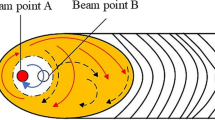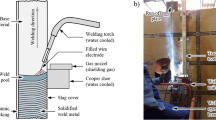Abstract
S960 and S700 are two new high strength steels recently developed by Tata Steel, UK. Due to the high power densities that can be achieved, small component distortion, and fast welding speeds, laser welding of thick section steels has been widely used in offshore construction and shipbuilding. However, the penetration depth is typically limited in single pass welding to 1–2 mm/kW laser power. Melt sagging is a typical defect for single pass autogenous laser welding of thick section materials. Multi-pass narrow gap laser welding techniques become more attractive because they can weld thicker sections of material with a moderate laser power and suppress the melt sagging problem. In addition, this approach requires less filler material, and the cumulative heat input to the material is reduced when compared with traditional arc welding techniques. However, there are many variables involved in this narrow gap laser welding technique, which makes this process more complicated than single pass autogenous laser welding. In this study, the effects of multi-pass ultra-narrow gap laser welding parameter interactions (i.e. laser power, welding speed and wire feed rate) on laser weld quality and the welding efficiency for S960 high strength steel plates were investigated. Moderate laser powers of 1 to 2 kW were used to weld S960 high strength steel plates with a very narrow parallel groove (1.2 mm). Statistical design of experiments was carried out to assess the process parameter interactions and to optimise the ultra-narrow gap laser welding parameters. Validation experiments indicate that the proposed models predict the responses adequately within the range of welding parameters that were used. Defect-free welds in 6 mm thick S960 steel were obtained with only two passes, using the optimised welding parameters, and these optimised parameters were successfully transferred to the welding of 8 mm thick S960 steel. In addition, they were also successfully transferred to the welding of 13 mm thick S700 steel with a small modification. The optimised narrow gap laser welded joints show almost the same tensile properties as the base material, with failures occurring in the base material away from the weld.
Similar content being viewed by others
References
Onoro J, Ranninger C (1997) Fatigue behaviour of laser welds of high-strength low-alloy steels. J Mater Process Technol 68(1):68–70. doi:10.1016/S0924-0136(96)02541-1
Shi G, Shi Y, Wang Y (2008) Engineering application of ultra-high strength steel structures. Prog Steel Build Struct 10(4):32–38
Yang Y, Lee S (1999) A study on the joining strength of laser spot welding for automotive applications. J Mater Process Technol 94(2):151–156. doi:10.1016/S0924-0136(99)00094-1
Mohandas T, Reddy GM (1997) A comparison of continuous and pulse current gas tungsten arc welds of an ultra high strength steel. J Mater Process Technol 69(1):222–226. doi:10.1016/S0924-0136(97)00022-8
Goodarzi M, Marashi S, Pouranvari M (2009) Dependence of overload performance on weld attributes for resistance spot welded galvanized low carbon steel. J Mater Process Technol 209(9):4379–4384. doi:10.1016/j.jmatprotec.2008.11.017
Bai Y, Bai Q (2005) Subsea pipelines and risers. Elsevier, Oxford, UK
Guo W, Liu Q, Francis JA, Crowther D, Thompson A, Liu Z, Li L (2015) Comparison of laser welds in thick section S700 high-strength steel manufactured in flat (1G) and horizontal (2G) positions. CIRP Ann Manuf Technol 64(1):197–200. doi:10.1016/j.cirp.2015.04.070
Chen H-C, Pinkerton AJ, Li L, Liu Z, Mistry AT (2011) Gap-free fibre laser welding of Zn-coated steel on Al alloy for light-weight automotive applications. Mater Des 32(2):495–504. doi:10.1016/j.matdes.2010.08.034
Elmesalamy A, Li L, Francis J, Sezer H (2013) Understanding the process parameter interactions in multiple-pass ultra-narrow-gap laser welding of thick-section stainless steels. Int J Adv Manuf Technol 68(1–4):1–17. doi:10.1007/s00170-013-4739-x
Kristensen JK (2009) Laser and hybrid laser-GMA welding of structural steels a challenge to research and industry for two decades. Trends in Welding Research 2008: Proceedings of the 8th International Conference, pp 645 – 651
Bachmann M, Avilov V, Gumenyuk A, Rethmeier M (2014) Experimental and numerical investigation of an electromagnetic weld pool support system for high power laser beam welding of austenitic stainless steel. J Mater Process Technol 214(3):578–591. doi:10.1016/j.jmatprotec.2013.11.013
Bachmann M, Avilov V, Gumenyuk A, Rethmeier M (2014) Experimental and numerical investigation of an electromagnetic weld pool control for laser beam welding. Phys Procedia 56:515–524. doi:10.1016/j.phpro.2014.08.006
Zhang X, Ashida E, Tarasawa S, Anma Y, Okada M, Katayama S, Mizutani M (2011) Welding of thick stainless steel plates up to 50 mm with high brightness lasers. J Laser Appl 23(2):022002. doi:10.2351/1.3567961
Elmesalamy A, Francis J, Li L (2014) A comparison of residual stresses in multi pass narrow gap laser welds and gas-tungsten arc welds in AISI 316L stainless steel. Int J Press Vessel Pip 113:49–59. doi:10.1016/j.ijpvp.2013.11.002
Li R, Wang T, Wang C, Yan F, Shao X, Hu X, Li J (2014) A study of narrow gap laser welding for thick plates using the multi-layer and multi-pass method. Opt Laser Technol 64:172–183. doi:10.1016/j.optlastec.2014.04.015
Sun Z, Salminen A (1997) Current status of laser welding with wire feed. Mater Manuf Process 12(5):759–777. doi:10.1080/10426919708935183
Shi H, Zhang K, Xu Z, Huang T, Fan L, Bao W (2014) Applying statistical models optimize the process of multi-pass narrow-gap laser welding with filler wire. Int J Adv Manuf Technol 75(1–4):279–291. doi:10.1007/s00170-014-6159-y
Lee H-K, Han H-S, Son K-J, Hong S-B (2006) Optimization of Nd: YAG laser welding parameters for sealing small titanium tube ends. Mater Sci Eng A 415(1):149–155. doi:10.1016/j.msea.2005.09.059
Park YW, Rhee S (2008) Process modeling and parameter optimization using neural network and genetic algorithms for aluminum laser welding automation. Int J Adv Manuf Technol 37(9–10):1014–1021. doi:10.1007/s00170-007-1039-3
Benyounis K, Olabi A (2008) Optimization of different welding processes using statistical and numerical approaches—a reference guide. Adv Eng Softw 39(6):483–496. doi:10.1016/j.advengsoft.2007.03.012
Talaş Ş (2010) The assessment of carbon equivalent formulas in predicting the properties of steel weld metals. Mater Des 31(5):2649–2653. doi:10.1016/j.matdes.2009.11.066
Yu YC, Yang SL, Yin Y, Wang CM, Hu XY, Meng XX, Yu SF (2013) Multi-pass laser welding of thick plate with filler wire by using a narrow gap joint configuration. J Mech Sci Technol 27(7):2125–2131. doi:10.1007/s12206-013-0525-9
Benyounis K, Olabi A-G, Hashmi M (2008) Multi-response optimization of CO2 laser-welding process of austenitic stainless steel. Opt Laser Technol 40(1):76–87. doi:10.1016/j.optlastec.2007.03.009
Leigh S, Sezer K, Li L, Grafton-Reed C, Cuttell M (2009) Statistical analysis of recast formation in laser drilled acute blind holes in CMSX-4 nickel superalloy. Int J Adv Manuf Technol 43(11–12):1094–1105. doi:10.1007/s00170-008-1789-6
Box GE, Wilson K (1951) On the experimental attainment of optimum conditions. J R Stat Soc Ser B 13(1):1–45
Montgomery DC (2008) Design and analysis of experiments. Wiley
Khuri AI, Cornell JA (1996) Response surfaces: designs and analyses, vol 152. CRC Press, Boca Raton
Palani P, Murugan N (2007) Optimization of weld bead geometry for stainless steel claddings deposited by FCAW. J Mater Process Technol 190(1):291–299. doi:10.1016/j.jmatprotec.2007.02.035
Reisgen U, Schleser M, Mokrov O, Ahmed E (2012) Statistical modeling of laser welding of DP/TRIP steel sheets. Opt Laser Technol 44(1):92–101. doi:10.1016/j.optlastec.2011.05.025
Khan M, Romoli L, Fiaschi M, Dini G, Sarri F (2011) Experimental design approach to the process parameter optimization for laser welding of martensitic stainless steels in a constrained overlap configuration. Opt Laser Technol 43(1):158–172. doi:10.1016/j.optlastec.2010.06.006
Khan M, Romoli L, Fiaschi M, Dini G, Sarri F (2012) Multiresponse optimization of laser welding of stainless steels in a constrained fillet joint configuration using RSM. Int J Adv Manuf Technol 62(5–8):587–603. doi:10.1007/s00170-011-3835-z
Ruggiero A, Tricarico L, Olabi A, Benyounis K (2011) Weld-bead profile and costs optimisation of the CO2 dissimilar laser welding process of low carbon steel and austenitic steel AISI316. Opt Laser Technol 43(1):82–90. doi:10.1016/j.optlastec.2010.05.008
Author information
Authors and Affiliations
Corresponding author
Rights and permissions
About this article
Cite this article
Guo, W., Crowther, D., Francis, J.A. et al. Process-parameter interactions in ultra-narrow gap laser welding of high strength steels. Int J Adv Manuf Technol 84, 2547–2566 (2016). https://doi.org/10.1007/s00170-015-7881-9
Received:
Accepted:
Published:
Issue Date:
DOI: https://doi.org/10.1007/s00170-015-7881-9




